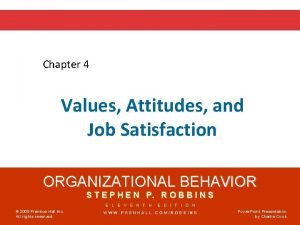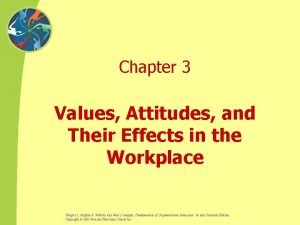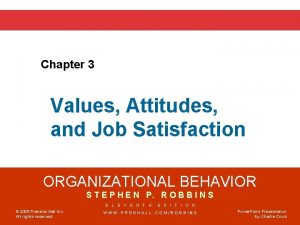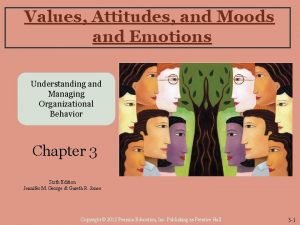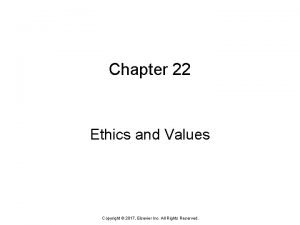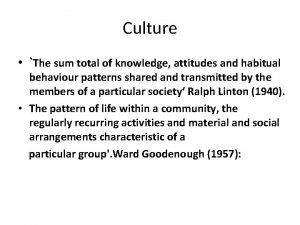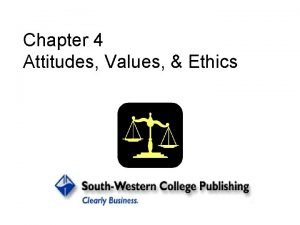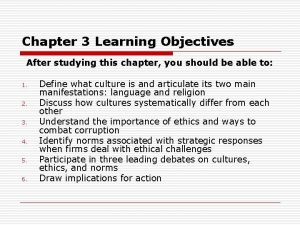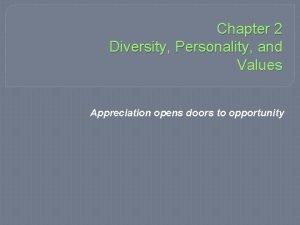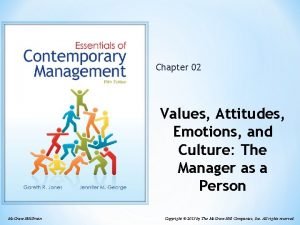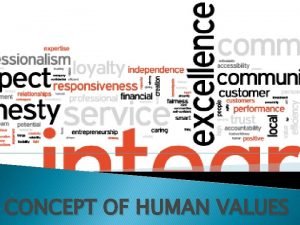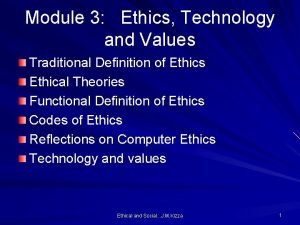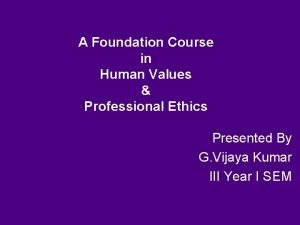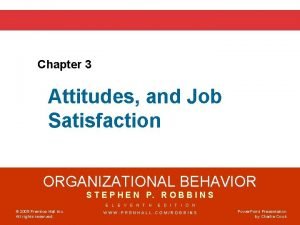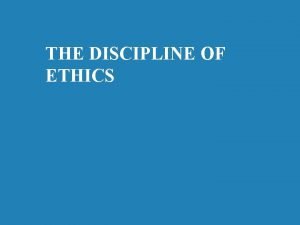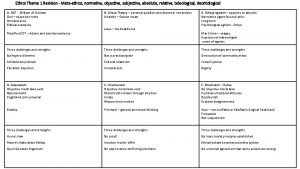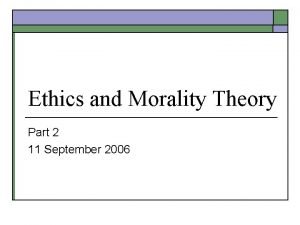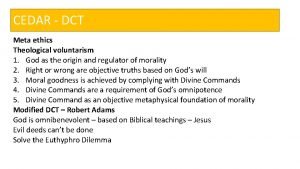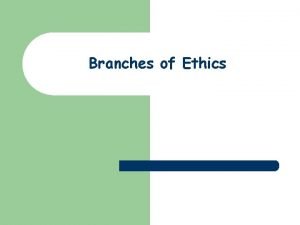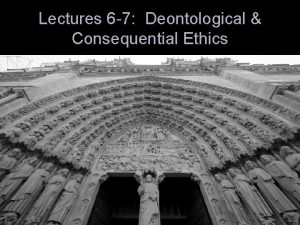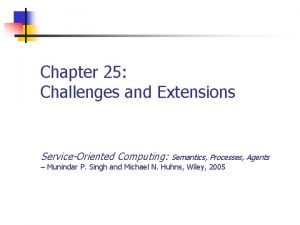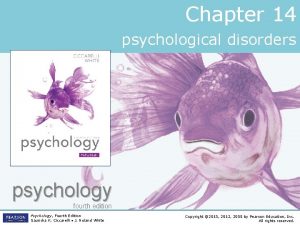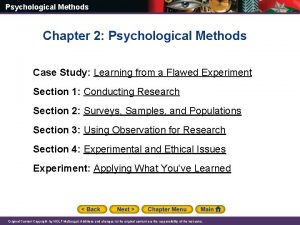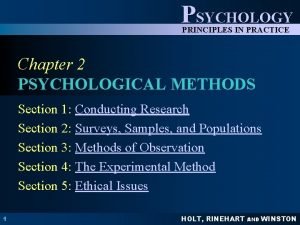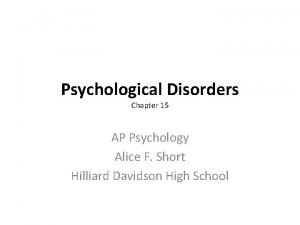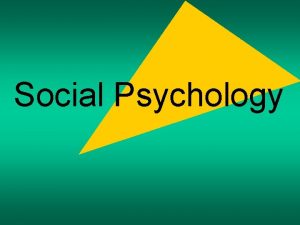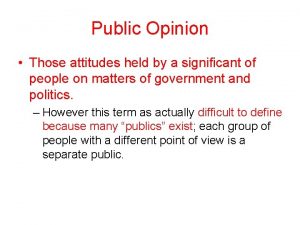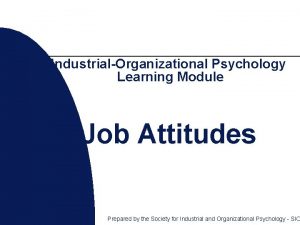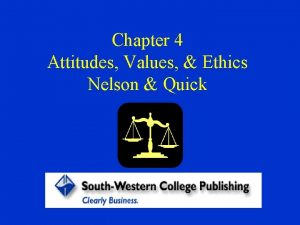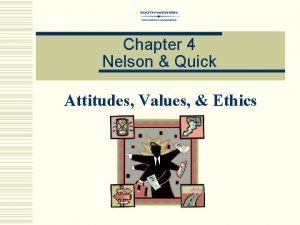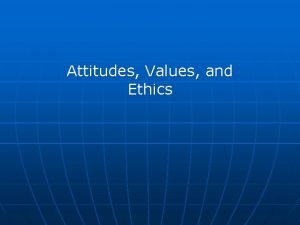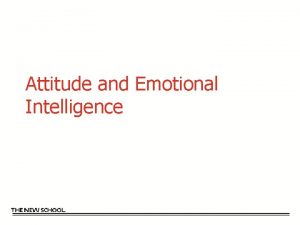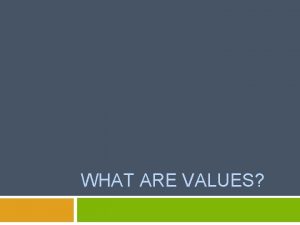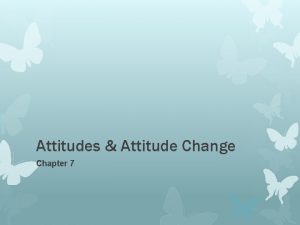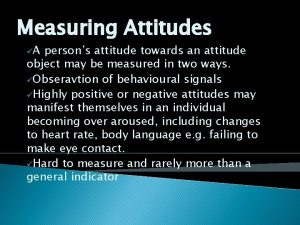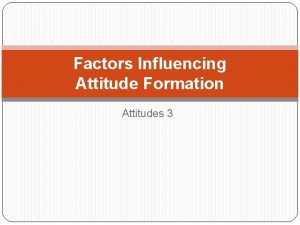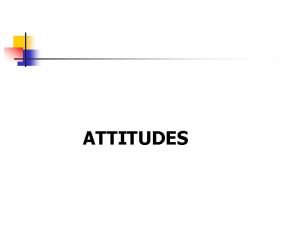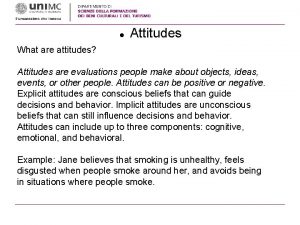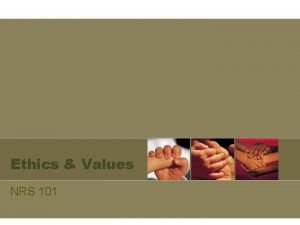Chapter 4 Attitudes Values Ethics Attitude a psychological




































![Gilligan’s Research: “shift[s] the focus of attention from ways people reason about hypothetical dilemmas Gilligan’s Research: “shift[s] the focus of attention from ways people reason about hypothetical dilemmas](https://slidetodoc.com/presentation_image_h/a154adfbfcf83a462d8a2aed1ee3f5d6/image-37.jpg)








- Slides: 45

Chapter 4 Attitudes, Values, & Ethics

Attitude - a psychological tendency expressed by evaluating an entity with some degree of favor or disfavor Should poor performance be blamed on “bad attitude”?

ABC Model of an Attitude Component A ffect B ehavioral intentions C ognition Measured by Example Physiological indicators Verbal statements about feelings I don’t like my boss. Observed behavior Verbal statements about intentions Attitude scales Verbal statements about beliefs I want to transfer to another dept. I believe my boss plays favorites. M. J. Rosenberg and C. I. Hovland, “Cognitive, Affective, and Behavioral Components of Attitude, ” in M. J. Rosenberg, C. I. Hovland, W. J. Mc. Guire, R. P. Abelson, and J. H. Brehm, Attitude Organization and Change, 1960

Cognitive Dissonance - a state of tension that is produced when an individual experiences conflict between attitudes and behavior attitude behavior

Two Influences on Attitude Formation Direct Experience Social Learning - the process of deriving attitudes from family, peer groups, religious organizations, and culture

Four Processes for Social Learning through Modeling The learner must Focus on the model Retain what was observed Practice the behavior Be motivated

Attitude-Behavior Correspondence Requirements Attitude specificity - a specific attitude Attitude relevance - some self-interest Measurement timing - measurement close to observed behavior Personality factors - ex. self-monitoring Social constraints - acceptability

Work Attitudes: Job Satisfaction - a pleasurable or positive emotional state resulting from the appraisal of one’s job or job experience Organizational Citizenship Behavior – Behavior that is above and beyond duty – Related to job satisfaction

Work Attitudes: Organizational Commitment The strength of an individual’s identification with an organization Affective Commitment Continuance Commitment Normative Commitment

Values - enduring beliefs that a specific mode of conduct or end state of existence is personally or socially preferable to an opposite or converse mode of conduct or end state of existence

Values Instrumental - values that represent the acceptable behaviors to be used in achieving some end state Terminal - values that represent the goals to be achieved, or the end states of existence

Work Values Achievement (career advancement) Concern for others (compassionate behavior) Honesty (provision of accurate information) Fairness (impartiality)

Cultural Differences in Values Authority is a right of office and rank Group input is important. Decisions should be challenged. France The Netherlands

Handling Cultural Differences Learn about others’ values Avoid prejudging Operate legitimately within others ethical points of view Avoid rationalizing Refuse to violate fundamental values Be open and above board

Ethical Behavior - acting in ways consistent with one’s personal values and the commonly held values of the organization and society.

Qualities Required for Ethical Decision-making The competence to identify ethical issues and evaluate the consequences of alternative courses of action The self-confidence to seek out different opinions about the issue and decide what is right in terms of a situation Tough-mindedness--the willingness to make decisions when all that needs to be known cannot be known and when the ethical issue has no established, unambiguous solution

Individual/Organizational Model of Ethical Behavior Individual Influences Value systems Locus of control Machiavellianism Cognitive moral development Organizational Influences Codes of conduct Norms Modeling Rewards and punishments Ethical Behavior

Values, Ethics & Ethical Behavior Value Systems - systems of beliefs that affect what the individual defines as right, good, and fair Ethics - reflects the way values are acted out Ethical behavior - actions consistent with one’s values

Machiavellianism - A personality characteristic indicating one’s willingness to do whatever it takes to get one’s own way

Ethics The system of rules that governs the ordering of values. Addresses such questions as: – What are the meanings of the ethical concepts of good and right? – How can a person reach a conclusion about an ethical dilemma? – Do ethical dilemmas have answers that would be universally accepted as right, proper, and appropriate?

Ethics Universalism – States that individuals should uphold certain values, like honesty, regardless of the results. The important values are the ones society needs to function. (Rule based or deontological, an inherent ‘right’ apart from any consequences. ) Utilitarianism – States that the greatest good for society should be the overriding concern of decision makers. (Consequential, or teleological) emphasizes the results of behavior. )

Ethics Justice Theories – State moral standards are based upon the primacy of a single value, which is justice. Everyone should act to ensure a more equitable distribution of benefits, for this promotes self-respect, essential for social cooperation. The Four Way Test 1. Is it the TRUTH? 2. Is if FAIR to all concerned? 3. Will it build GOODWILL and better friendships? 4. Will it be BENEFICIAL to all concerned?

Moral Reasoning The thinking processes involved in judgments about questions of right and wrong. Kohlberg’s work (’ 63, ’ 75, ’ 81): – Divided moral development into three

Moral Reasoning Pre-conventional – Judgment based solely on a person’s own needs and perceptions Conventional – Expectations of society and law are taken into account Post-Conventional – Judgment based on abstract, personal principles not necessarily defined by society’s laws.

Kohlberg’s Moral Dilemmas Hypothetical situations in which no choice is clearly and indisputably right.

The Heinz Dilemma A man’s wife is dying. There is one drug that could save her life, but it is very expensive, and the druggist who invented it will not sell it at a price low enough for the man to buy it. Finally, the man becomes desperate and considers stealing the drug for his wife. What should he do and why?

Kohlberg’s Work Stage 1 (Pre conventional) – Punishment-obedience orientation • Fear of authority and avoidance of punishment are reasons for behaving morally. Stage 2 (Pre conventional) – Personal reward orientation • Satisfying personal needs determines moral choice.

Kohlberg’s Work Stage 3 (Conventional) – Good boy-nice girl orientation • Maintaining the affection and approval of friends and relatives motivates good behavior Stage 4 (Conventional) – Law and order/authority orientation • A duty to uphold rules and laws for their own sake justifies moral conformity

Kohlberg’s Work Stage 5 (Post conventional) – Social contract orientation • We obey rules because they are necessary for social order, but rules can be changed if there were better alternatives Stage 6 (Post conventional) – Morality of individual principles and conscience • Behavior which conforms to internal principles (justice and equality) and may sometimes violate society’s rules.

Carol Gilligan “In a Different Voice” 1977, 1981

Moral reasoning is delimited by “. . . two moral perspectives that organize thinking in different ways. ” Men: define morality in terms of justice. Women: less in terms of rights and more in terms of standards of responsibility and care.

Gilligan’s Perspective: Males = typically a justice/rights orientation Females = care response orientation Orientations arise form rational experiences of inequality and attachment Girls attached to and identify with mothers Boys attached to mothers and identify with fathers

Believes that: That response orientation is of a higher order than justice rights orientation Because Kohlberg’s theory is hierarchical with justice/rights the basis--women would necessarily show a less reasoned perspective on his scales. First studies of Kohlberg only conducted with men

The two perspectives are not opposite ends of a continuum, “. . . with justice uncaring and caring unjust. . . ”, but rather, “. . . a different method of organizing the basic elements of moral judgment: self, others, and the relationship between them. ” (Gilligan, 1987, p. 22)

“One moral perspective dominates psychological thinking and is embedded in the most widely used measures for measuring maturity of moral reasoning. ” C. Gilligan, 1987, p. 22

Gilligan’s Theory Based on two observational studies. Study One: 25 college students Study Two: 29 women considering abortion
![Gilligans Research shifts the focus of attention from ways people reason about hypothetical dilemmas Gilligan’s Research: “shift[s] the focus of attention from ways people reason about hypothetical dilemmas](https://slidetodoc.com/presentation_image_h/a154adfbfcf83a462d8a2aed1ee3f5d6/image-37.jpg)
Gilligan’s Research: “shift[s] the focus of attention from ways people reason about hypothetical dilemmas to ways people construct moral conflicts and choice in their lives. . . and [makes] it possible to see what experiences people define in moral terms, and to explore the relationship between the understanding of moral problems and the reasoning strategies used and the actions taken in attempting to solve them. ” Gilligan, 1987, p. 21

Alternative Stage Sequence: Three levels with transitional phases between each: Level One: Complete concern for self (Individual Survival). Transitional Phase: From self to care and concern for others.

Level Two: Primary interest in the care of others (to gain their acceptance) (Self sacrifice and Social conformity). Transitional Phase: awareness of self relative to developing relationships with others: responsibility toward their care and needs.

Level Three: Nonviolence and universal caring. “articulates an ethic of responsibility that focuses on the actual consequences of choice, , , the criterion of adequacy or moral principles changes from objective truth to ‘best fit’, and can only be established within the context of the dilemma itself. ” Murphy and Gilligan, 1980, p. 83

Good Points: Concept of care giving and nurturing Relationship of self to others, responsibility Empathy Effect on environment

Hawthorne Effect: Subjects may try harder simply because they are in the control group.

Rosenthal Effect: Researcher’s biases tend to sway the results to be what the researcher wants to find

“Rather than arguing over the extent to which sex bias is inherent in Kohlberg’s theory of moral development, it might be more appropriate to ask why the myth that males are more advanced in moral reasoning than females persists in light of such little evidence. ” Walker, 1984, p. 688

Cognitive Moral Development - The process of moving through stages of maturity in terms of making ethical decisions Level l Premoral Level ll Conventional Level lll Principled
 Dominant work values in today's workforce
Dominant work values in today's workforce New zealand values and attitudes
New zealand values and attitudes Values and attitudes in the workplace
Values and attitudes in the workplace Values attitudes and job satisfaction
Values attitudes and job satisfaction Emotions and values
Emotions and values If a nurse decides to withhold a medication
If a nurse decides to withhold a medication Culture is the sum total of
Culture is the sum total of Attitude in ethics
Attitude in ethics Western values vs eastern values
Western values vs eastern values Machavillian
Machavillian Instrumental values
Instrumental values Fill in the blanks the base of binary number system is
Fill in the blanks the base of binary number system is Define human value
Define human value Definition of values in ethics
Definition of values in ethics What is moral value
What is moral value Vital values
Vital values Cbsa values and ethics
Cbsa values and ethics Conservation values and ethics
Conservation values and ethics Foundation course in human values and professional ethics
Foundation course in human values and professional ethics Attitudes and job satisfaction
Attitudes and job satisfaction Descriptive ethics
Descriptive ethics Non cognitivism
Non cognitivism Define micro and macro ethics
Define micro and macro ethics Factual inquiry in ethics
Factual inquiry in ethics Meta ethics vs normative ethics
Meta ethics vs normative ethics Descriptive ethics vs normative ethics
Descriptive ethics vs normative ethics Descriptive ethics vs normative ethics
Descriptive ethics vs normative ethics Meta ethics vs normative ethics
Meta ethics vs normative ethics Meta ethics vs normative ethics
Meta ethics vs normative ethics Deontology ethics example
Deontology ethics example Teleological ethics vs deontological ethics
Teleological ethics vs deontological ethics Chapter 18 psychological disorders
Chapter 18 psychological disorders Chapter 18 psychological disorders
Chapter 18 psychological disorders Chapter 14 psychological disorders
Chapter 14 psychological disorders Single blind study
Single blind study Psychology chapter 2 section 1
Psychology chapter 2 section 1 Chapter 14 psychological disorders
Chapter 14 psychological disorders Ap psychology chapter 15
Ap psychology chapter 15 Module 74: attribution, attitudes, and actions
Module 74: attribution, attitudes, and actions Tripartite theory of attitude
Tripartite theory of attitude Personal attitudes and dispositions also shape behavior
Personal attitudes and dispositions also shape behavior Characteristics of quality culture
Characteristics of quality culture Attitudes held by a significant number
Attitudes held by a significant number Attitudes de porter
Attitudes de porter Types of attitude
Types of attitude Attitudes in psychology
Attitudes in psychology
